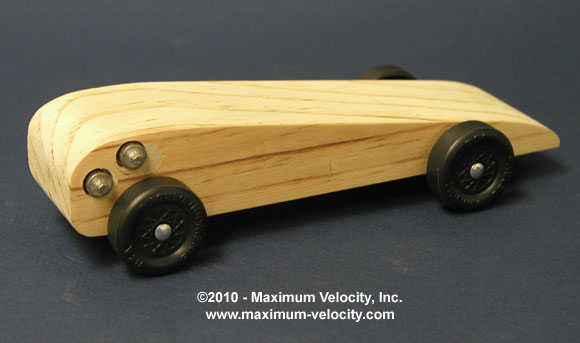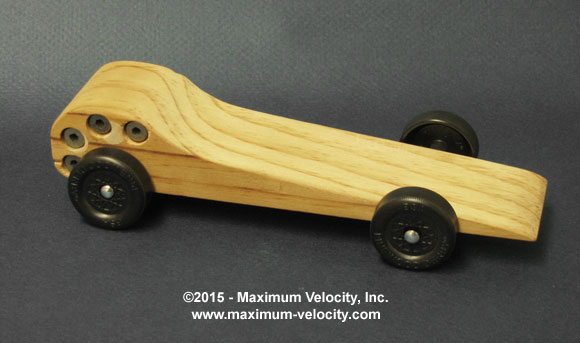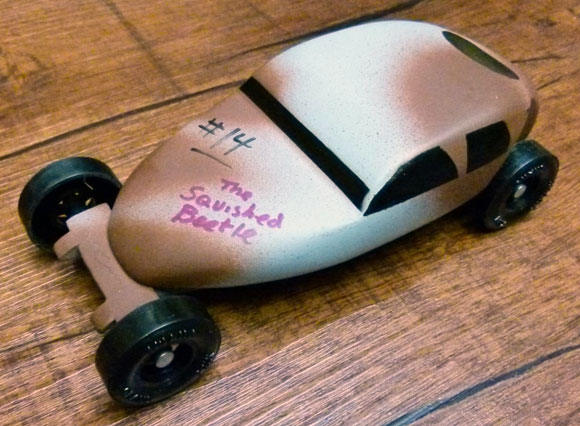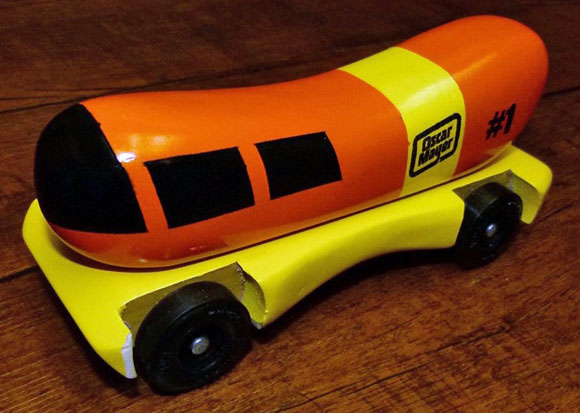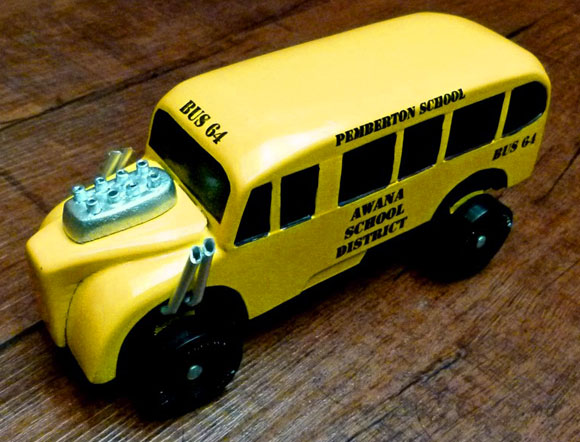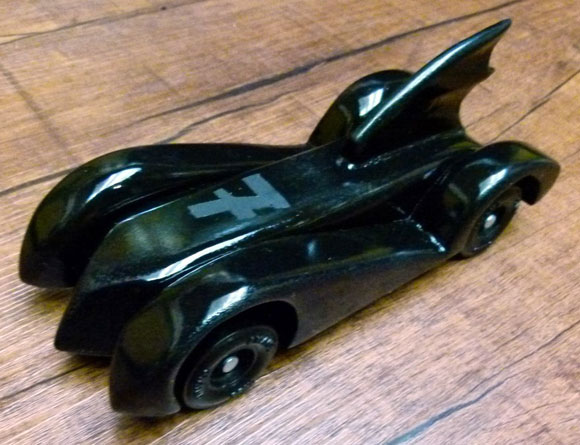– Feature Article – Offset Weight Placement: Part 2
– Humor
– Pinewood Derby Car Showcase
– Memory – Up In Flames!
– Q&A
Feature Article
Offset Weight Placement – Part 2
By Randy Davis
Back in 2011, I did an experiment on side to side weight placement1 which was documented in Volume 10 Issue 8. In that experiment, on a three-wheeled car the left-to-right center of gravity was shifted left, then right, and then evenly balanced on the rear wheels. The effect of alignment was then checked for each weight position. The result was that there was no meaningful effect on the alignment of the car due to the left-right position of the weight.
Further Consideration
After some consideration I decided that the experiment was not complete. First, I did not measure the actual performance of the car on the track. Secondly, the balance point of the car was fairly conservative (less weight on rear wheels).
So, I decided to modify the test car and redo the experiment with track testing. I decided to eliminate the left shift of the weight and focused on Center Weighting and Balanced Weighting.2
Figure 1 – Original Test Car
The original test car held four COG weights, two in each side hole, and a small amount of trim weight just in front of the rear axle.
Figure 2 – New Test Car
The new test car has four COG weights, one in each side hole, and just over one ounce of weight just in front of the rear axle. This results in a more aggressive center of gravity (3/4 inch in front of rear axle), and a greater amount of side-to-side adjustment.
Experiment Setup
The car was equipped with polished BSA Speed Axles and Pro-Stock Speed Wheels, and lubricated with Krytox 100. The front dominant axle was bent and adjusted for railing riding,
When Center Weighting was configured, there was 2.54 ounces on the left-rear wheel and 1.64 ounces on the right-rear wheel. When Balanced Weighting was configured, there was 2.09 ounces on both wheels.
Results
Each configuration was run ten times, and the times were averaged and a standard deviation calculated.
In harmony with the first experiment, the results showed no measurable difference between Center Weighting and Balanced Weighting.
2.553 – Center Weighting Average, .0017 Std Dev
2.554 – Balanced Weighting Average, .0029 Std Dev
Conclusion
So, I think I can just paraphrase the conclusion from the first article. Placing the weight such that it is evenly distributed on the rear wheels is the theoretical correct technique. However, a centered weight placement will not have any effect on the performance of the car.
1For a discussion as to why the left-right weight placement is theoretically of interest, please refer to the original article.
2“Center Weighting” places the weight in the left-to-right center of the car body. “Balanced Weighting” places the weight so that the rear wheels have an equal weight load.
Humor
When my three-year-old son opened the birthday gift from his grandmother, he discovered a water pistol. He squealed with delight and headed for the nearest sink. I was not so pleased. I turned to Mom and said, “I’m surprised at you. Don’t you remember how we used to drive you crazy with water guns?”
Mom smiled and then replied…..”I remember.”
Car Showcase
Today’s cars were submitted by Dennis Pemberton
Squished Beetle
My version of a chopped Beetle. I made it at the last minute. It started out with a light blue finish but the spray can was old and I got horrendous “orange peel”. So I sanded it down and sprayed two different shades of primer – like a true Rat Rod!
“Oh, I Wish I Were …”
My wife made this Oscar Mayer Wienermobile. We used a chunk of balsa for the wiener, and the thing still came in at almost 5 ounces.
Bus 64
My entry in the Awana Grand Prix. I had to make the sides out of sheet plastic because even 1/4 inch poplar sides were too heavy. I was not real happy with the motor. The bus was surprisingly stable with so much weight on top.
Batmobile
My daughter’s Batmobile. Although it doesn’t show very well in the picture, the number 7 is actually the first coat of gloss black, sanded down. I then masked the 7, and shot another coat of gloss black on top. The result was a subtle, shadowy seven.
Pinewood Derby Memory
Up In Flames!
We were building four cars for the upcoming derby race. It was the weekend before the race, and the cars were finally painted. For some reason the yellow paint on one of the cars just didn’t seem to be drying.
A dim light bulb suddenly switched on inside my head – I could use the microwave to dry the car! Quickly, I put the car on a paper plate, stuck it in the microwave, and turned it on. I left the room for a few moments, and then all of a sudden I heard a scream coming from the kitchen. I quickly rushed back in and found the car in flames, with the owner (my lady friend’s 13 year old) screaming in horror! I quickly shut off the microwave and removed the car. It was rather warm to the touch, the paint was burnt and slightly bubbled, and the 13 year old was crying, (not to mention the stench which remained in the house for a week). With a lot of sanding, repainting, and consoling, we managed to get the car completed on time.
On race day all of the trouble was justified. The car won 1st place for speed in its division and took 2nd place in the design category.
I don’t think we will quickly forget the “Flaming Car”, and will certainly leave the microwave out of our car building process in the future.
Duane Hittle
Capac, Michigan
Q&A
On most all of your technical reports five inches of steer is used most of the time. This makes the car a “rail pusher” more then a rail- rider. Could a timed test be done using 1, 2, 3, 4 and 5 inches of steer?
Generally, you need a decent amount of drift to make sure the dominant wheel stays on the rail. If it comes off the rail, then the car can become unstable, losing the advantage of rail-riding.
Tracks vary in their quality and setup, so 5 inches over 8 feet is recommended to overcome most track issues. It is possible that on a very smooth and level track the drift could be less. But even on my smooth aluminum track, which is leveled, five inches (and sometimes more) of drift is needed to make sure a car with an aggressive COG stays on the rail. But the amount of drift required is track dependent.
I want to enter a fund raiser event in the outlaw class which allows powered cars. I have a Fan Powered car from many years ago (the orange one). You have the V3 available but I’m not sure if I will be allowed to charge the car prior to each heat. Not sure what the V2 was but I assume it was faster than the version I have. Did the V2 run on a battery or capacitors? Are the V1 and V2 fan powered kits still available?
The V2 was the first capacitor car, with the same sized fan as the V1. The V3 has a larger fan and altered component mounting. Neither V1 or V2 are available.
One solution, albeit a bit ugly, is to use the V3 and mount a 9V battery on top of the car, plugged into the jack. Then the capacitors will charge while the car is staged. Preferably it needs 30 seconds to charge. Note that the weight of the battery may slow it down a bit.
Want Answers?
Do you have a pinewood derby-related question? If so, e-mail us your question.We answer all questions by e-mail, but not every question will appear in the Q&A section of the newsletter.
Back Issues
Are you a new subscriber, or have you missed some of the previous newsletters? Don’t miss out; all of the issues for Volume 5 through Volume 17 are posted on our web site.
Newsletter Contributions
We welcome your contributions. If you would like to contribute an article, a web site review, a speed tip, or a pinewood derby memory, please e-mail us.
Subscription Information
The Pinewood Derby Times is a free e-newsletter focused on pinewood derby racing. It is published biweekly from October through March.
If you haven’t already done so, please forward this issue to your pinewood derby friends. But please don’t subscribe your friends. Let them decide for themselves. Thanks.
If this newsletter was forwarded to you, why not subscribe to receive this newsletter. There is no cost, and your e-mail address is safe, as we never sell or share our distribution list.
To subscribe, send a blank e-mail to
pi*********************@*******st.com
You will receive a confirmation e-mail. Reply to the confirmation e-mail and you will start receiving the Pinewood Derby Times with the next issue.
Randy Davis, Editor, Pinewood Derby Times
E-Mail: in**@**************ty.com
(C)2018, Maximum Velocity, Inc. All rights reserved. Please do not reprint or place this newsletter on your web site without explicit permission. However, if you like this newsletter we grant permission, and encourage you to e-mail it to a friend.
Maximum Velocity disclaims any personal loss or liability caused by utilization of any information presented in this newsletter.
The Pinewood Derby Times is not specific to, and is not affiliated with the Boy Scouts of America, YMCA, Awana, or any other organization.
(R)Maximum Velocity is a registered trademark of Maximum Velocity, Inc.
(R)Pinewood Derby is a registered trademarks of the Boys Scouts of America.
(R)Awana is a registered trademark of Awana Clubs International.
All other names are trademarks of their respective owners.

